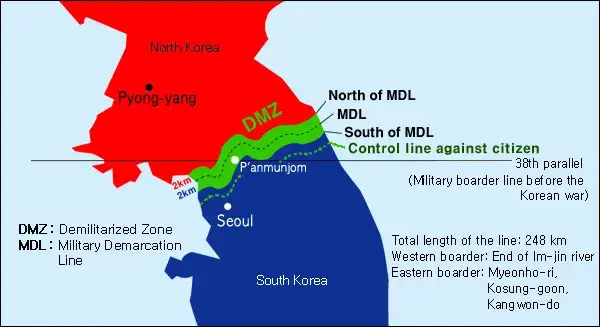
It was 6 a.m. on a stormy, sweltering summer morning when I left my Seoul hotel, lightning cracking the sky and my cheap umbrella snapping in the wind. What started as a light drizzle turned into torrential rain, the kind that soaks you to the bone. South Korea was battered by such heavy storms that week in July 2025 that, tragically, 17 people lost their lives and 11 went missing over the coming days. Yet, here I was, fumbling through the Seoul subway system, heart pounding with worry I’d miss my DMZ tour coach. The signs were a blur, but somehow, I made it to the meeting point, drenched but determined. By the time we reached the Demilitarized Zone (DMZ), the skies had calmed to a moody overcast—no rain, just a heavy stillness that set the tone for a day I’ll never forget.
This leg of my STRONGER tour focuses solely on Imjingak Peace Park, a place steeped in the weight of Korea’s divided history. The DMZ, a 250-kilometer-long, 4-kilometer-wide buffer zone established in 1953 after the Korean Armistice Agreement, splits the Korean Peninsula along the 38th parallel. Created to halt the Korean War (1950–1953), it’s not a place of peace but one of the world’s most militarized borders, bristling with barbed wire, minefields, and the constant watch of soldiers from both North and South. Despite its name, the DMZ is a stark reminder of a war that never truly ended, with no formal peace treaty ever signed. Imjingak Park, built in 1972 in Paju, Gyeonggi-do, stands just outside the DMZ’s Civilian Control Zone as a symbol of solace for families torn apart by the division and a beacon of hope for reunification.

The park itself is a mix of solemnity and surprising normalcy. You’ll find memorials like the Wall of Remembrance, etched with names of those lost or separated, and the Freedom Bridge, built in 1953 to allow 12,773 prisoners of war to cross back to South Korea. Ribbons of prayers flutter on barbed wire fences, each one a whisper of longing for families still divided. Nearby, the Peace Bell, rung daily at noon, calls for unity, while Dorasan Station, the northernmost railway stop in South Korea, stands ready for a day when trains might cross into the North. There’s even a small amusement park, Pyeonghwa Land, which feels oddly out of place amid the weight of history. But that contrast captures the park’s essence—a place where grief and hope coexist, where South Koreans come to picnic, reflect, and dream of a different future.


Security at the DMZ is tight, and some areas, like the Third Infiltration Tunnel or Dora Observatory’s view into North Korea, are off-limits for filming or photography. North Korean soldiers have been known to use tourist photos for propaganda, so you’re constantly reminded to keep cameras pointed only where allowed. But the most profound moment of my day wasn’t captured on video or in a photo—it was a conversation with a North Korean defector, a woman whose story broke my heart. Her name can’t be shared, as her safety depends on anonymity, but her words will stay with me forever. She spoke of her harrowing escape, losing her mother and brother to the North Korean regime’s brutality. When I asked if she missed anything about North Korea, her answer was raw and human: no matter how cruel the regime, her childhood home and town were there, and a piece of her heart would always belong to that place. Her story wasn’t just a headline—it was a reminder of the human cost of division, and it brought tears to my eyes.

I’ll be honest: I went into this tour thinking the DMZ might just be a hyped-up tourist trap, good for a selfie and not much else. I was wrong. Imjingak Peace Park and the DMZ are a gut-punch of history, resilience, and raw emotion. You don’t just see the border; you feel the weight of a nation’s story. The Korean War, sparked when North Korea invaded the South in 1950 with Soviet backing, left millions dead or displaced and a peninsula permanently scarred. The armistice, signed in Panmunjom’s Peace House, paused the fighting but left families shattered and a border bristling with tension. Visiting the DMZ strips away the political spin of news reports, replacing it with real stories—of soldiers, defectors, and families still praying for reunification.


To truly share the magic and gravity of Imjingak, I’ve got a longer video that walks you through the park’s sights and stories. Words alone can’t capture the rustle of prayer ribbons, the somber toll of the Peace Bell, or the quiet power of standing so close to a divided land. This wasn’t just a tour; it was one of the best days of my life, a rollercoaster of emotions that taught me more about Korea, its people, and their hopes than any news article ever could. If you’re in South Korea, don’t skip the DMZ. It’s not just a place—it’s a journey into the heart of a nation’s past and its dreams for the future. Trust me, you’ll leave changed.
Add comment
Comments